Nursery rhymes will help you teach your children their first English words! These 9 fun modern and classic rhymes will turn your child’s education into something truly special.
For hundreds of years, nursery rhymes have been one of the most fun, effective, and engaging ways to teach children just about anything. Vocabulary, grammar, as well as rules and moral principles! Their melodies and rhythms sync the minds and bodies of our little ones, preparing them for life at school and onwards.

Nursery rhymes are perfect for teaching new words. Their simple rhythms and catchy tunes grab children’s attention which helps them develop their language skills naturally and playfully.
In this article, you’ll find 9 nursery rhymes that will get those little hands clapping and feet tapping, making learning English fun and memorable.
Indice dei contenuti
Benefits of singing English nursery rhymes with children
Singing nursery rhymes in English offers many educational and developmental benefits. Here’s why it’s worth including them in your child’s daily life:

🧠 1. Boosts memory and concentration
Memorising songs helps strengthen cognitive skills. Children learn to pay attention, remember sequences of words, and anticipate rhyming sounds.
🗣️ 2. Improves pronunciation and intonation
By repeating what they hear, children start to imitate native pronunciation, rhythm, and intonation. Songs help them become familiar with the natural flow of English.
🧾 3. Expands vocabulary
Nursery rhymes introduce new words in a fun, contextualised way, making it easier for children to understand and remember them.
📖 4. Lays the foundation for reading and writing
Rhymes, rhythm, and repetition help children recognise sound patterns, an important early literacy skill. Singing can also help children associate written words with their spoken forms.
😃 5. Increases motivation and emotional involvement
Songs are fun! They encourage participation and make the learning experience enjoyable and emotionally positive — which is key to keeping children engaged.
👨👩👧 6. Promotes bonding
Singing together strengthens the bond between the child and the adult, creating shared moments that are fun and memorable.
These playful songs allow children to engage with language and rhythm in a way that is most natural to them—through play! Part of their magic is their lifespan, as many nursery rhymes we sing today have been passed down through the generations.
Why are rhyming songs so easy to learn?
Rhyming is the art of using words that sound the same, or at least similar, at the end of each sentence, and it’s widely used in songs and poetry. It’s so effective because the repetitive structure and rhythm of nursery rhymes makes them so much easier to memorise.

In fact, rhyme and alliteration make these songs pleasing to hear which enhances our ability to recall them.
Plus, their use of simple words and short lines helps children follow along and remember the lyrics more easily, even in a second language. Children often don’t want to speak English right away and can feel frustrated when they struggle to express themselves verbally.
Nursery rhymes give them a little boost, helping them feel like they’re already speaking English from their very first lessons.
1. Hot cross buns
This popular rhyme tops the list for many! Hot Cross Buns teaches children the value of sharing.
It’s simple and great for roleplay, as you can help your kids fire up their imagination as they pretend to buy and sell these English buns while you sing the song together.
Hot cross buns,
Hot cross buns,
One a penny,
Two a penny,
Hot cross buns,
Give them to your daughters,
Give them to your sons,
One a penny,
Two a penny,
Hot cross buns.
2. Row, row, row your boat
Now this is a timeless classic! With its calm, repetitive rhythm and language, this is ideal for group activities where children can mime rowing while they sing.
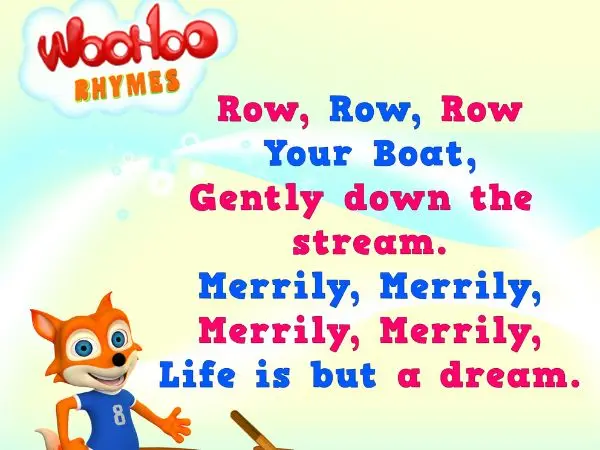
Singing this alongside the rowing action is especially effective as the rhyme introduces words related to movement, whilst also offering a peaceful, reassuring view of life!
Row, row, row your boat
Gently down the stream
Merrily, merrily, merrily, merrily
Life is but a dream
Row, row, row your boat
Gently down the stream
Merrily, merrily, merrily, merrily
Life is but a dream
Row, row, row your boat
Gently down the stream
Merrily, merrily, merrily, merrily
Life is but a dream
Row, row, row your boat
Gently down the stream
Merrily, merrily, merrily, merrily
Life is but a dream
Row, row, row your boat
Gently down the stream (row, row, row your boat)
Row, row, row your boat (gently down the stream)
Gently down the stream (merrily, merrily, merrily, merrily)
Merrily, merrily, merrily, merrily (gently down the stream)
Life is but a dream (merrily, merrily, merrily, merrily)
Life is but a dream
Life is but a dream
3. The wheels on the bus
This one is perfect for having lots of fun! The Wheels on the Bus is interactive and has matching dance moves, so its great for teaching not only the parts of a bus, but reinforces their meaning by combing the actions.
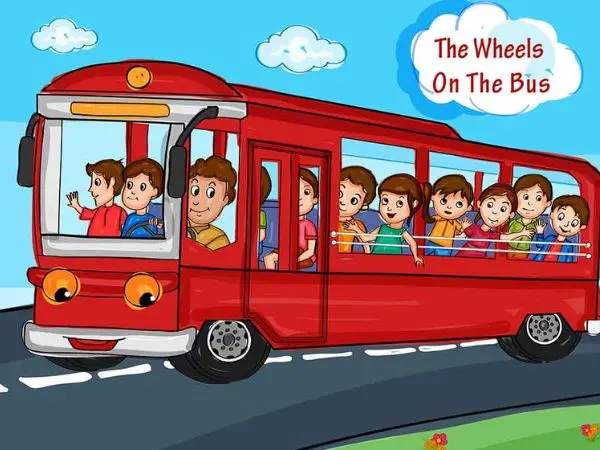
Each verse introduces a new sound or action, like the wipers going “swish, swish, swish” and the babies going “wah, wah, wah.”
The wheels on the bus go round and round,
round and round,
round and round.
The wheels on the bus go round and round,
all through the town.
The wipers on the bus go swish, swish, swish;
Swish, swish, swish;
Swish, swish, swish.
The wipers on the bus go swish, swish, swish,
all through the town.
The Driver on the bus says, “move on back,
move on back, move on back;”
The Driver on the bus says, “move on back”,
all through the town.
The babies on the bus say, “wah, wah, wah;
Wah, wah, wah;
Wah, wah, wah”.
The babies on the bus say, “wah, wah, wah,”
all through the town.
The mommies on the bus say, “shush, shush, shush;
Shush, shush, shush;
Shush, shush, shush.”
The mommies on the bus say, “shush, shush, shush”
all through the town.
4. Baa baa black sheep
This well-loved rhyme teaches your children kindness and sharing through the tale of a sheep giving away its wool. It’s also helpful for teaching them their numbers!
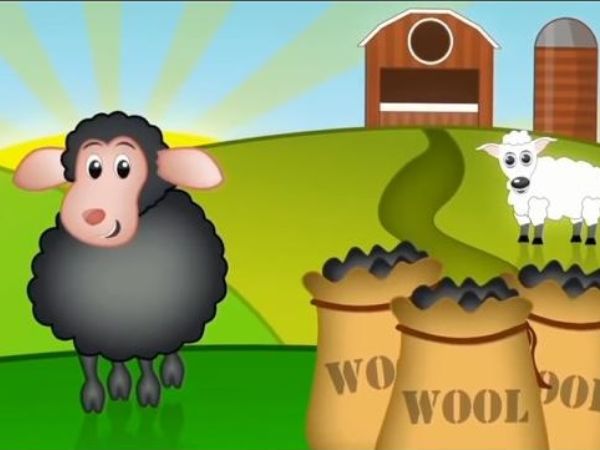
Baa, baa, black sheep, have you any wool?
Yes, sir, yes, sir, three bags full
One for the master, one for the dame
One for the little boy who lives down the lane
Baa, baa, black sheep, have you any wool?
Yes, sir, yes, sir, three bags full
Baa, baa, blue sheep, have you any wool?
Yes, sir, yes, sir, three bags full
One for the master, one for the dame
One for the little boy who lives down the lane
Baa, baa, blue sheep, have you any wool?
Yes, sir, yes, sir, three bags full
Baa, baa, pink sheep, have you any wool?
Yes, sir, yes, sir, three bags full
One for the master, one for the dame
One for the little boy who lives down the lane
Baa, baa, pink sheep, have you any wool?
Yes, sir, yes, sir, three bags full
Baa, baa, white sheep, have you any wool?
Yes, sir, yes, sir, three bags full
One for the master, one for the dame
One for the little boy who lives down the lane
Baa, baa, white sheep, have you any wool?
Yes, sir, yes, sir, three bags full
5. Miss Polly Had a Dolly
Miss Polly Had a Dolly tells the sweet story of Miss Polly and her poorly dolly. She calls the doctor, who arrives promptly to look after the patient!
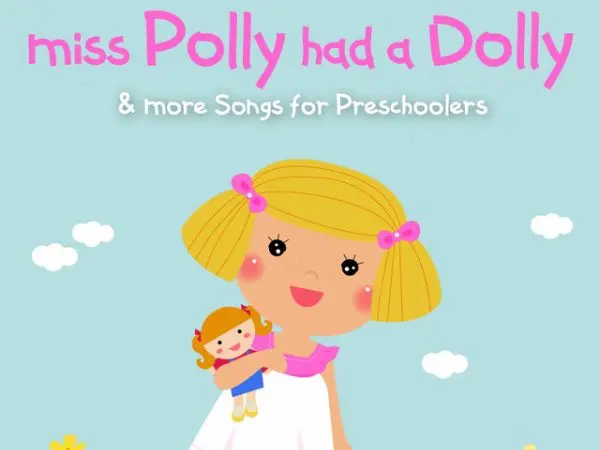
This simple story not only helps your child grow their English vocabulary, but it encourages empathy, all within a safe context as the poorly one is only a doll. It’s great for introducing children to the idea of looking after others, learning the names of different characters, and understanding the instructions from the doctor.
Miss Polly had a dolly who was sick, sick, sick.
So she called for the doctor to come quick, quick, quick.
The doctor came with his bag and his hat,
And he knocked on the door with a rat-a-tat-tat.
He looked at the dolly, and he shook his head,
And he said, “Miss Polly, put her straight to bed!”
He wrote on a paper for some pills, pills, pills,
“I’ll be back in the morning with my bill, bill, bill.”
6. Finger Family
This is a lively and playful children’s song that introduces family members in a creative and fun way, using the fingers of the hand.
Each finger represents a different family member: the thumb is the father, the index finger is the mother, the middle finger is the brother, the ring finger is the sister, and the pinkie is the baby.

With this nursery rhyme, you can teach children the names of family members while helping them develop coordination and memory through a playful and interactive activity.
Daddy finger, daddy finger, where are you?
Here I am, here I am
How do you do?
Mommy finger, mommy finger, where are you?
Here I am, here I am
How do you do?
Brother finger, brother finger, where are you?
Here I am, here I am
How do you do?
Sister finger, sister finger, where are you?
Here I am, here I am
How do you do?
Baby finger, baby finger, where are you?
Here I am, here I am
How do you do?
7. God’s Love Is So Wonderful
This song emphasises the wonder of God’s love, describing it as so high you can’t go over it, so deep you can’t go under it, and so wide you can’t go around it.

It’s very useful for introducing spatial prepositions such as over, under, and around in a memorable and heartfelt way.
God’s love is so wonderful
God’s love is so wonderful
God’s love is so wonderful
Oh! Wonderful love!
So high, you can’t get over it
So high, you can’t get over it
So high, you can’t get over it
Oh! Wonderful love!
So deep, you can’t get under it
So deep, you can’t get under it
So deep, you can’t get under it
Oh! Wonderful love!
So wide, you can’t get around it
So wide, you can’t get around it
So wide, you can’t get around it
Oh! Wonderful love!
God’s love is so wonderful
God’s love is so wonderful
God’s love is so wonderful
Oh! Wonderful love!
8. Jack and Jill
Jack and Jill is a classic nursery rhyme that tells the story of two children, Jack and Jill, who go up a hill to fetch a pail of water. Unfortunately, Jack loses his footing and falls down, breaking his crown, with Jill tumbling down right after him.
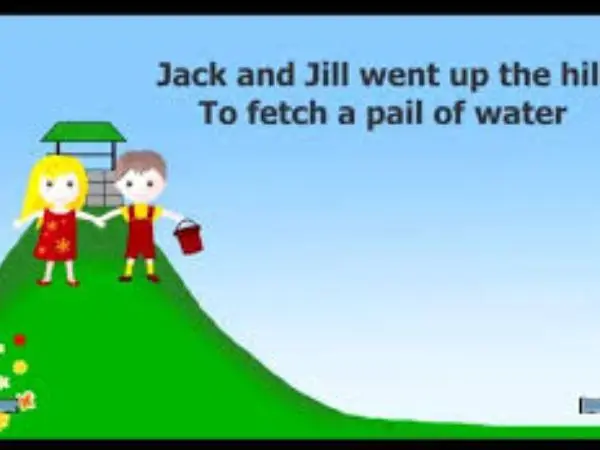
Jack and Jill went up the hill
To fetch a pail of water;
Jack fell down and broke his crown,
and Jill came tumbling after.
Up Jack got, and home did trot,
As fast as he could caper,
To old Dame Dob, who patched his nob
With vinegar and brown paper.
9. Five Ants Marching Up a Tree
This educational song teaches children to count backwards from five to zero. It tells the story of five ants marching up a tree, only to be eaten by a bird one by one.

One, two, three, four, five!
Five ants marching up a tree,
looking for some food to eat—
they had not the slightest hunch
that they’d be somebody else’s lunch.
Munch!
Oh, no! How many are left? Let’s count them …
One, two, three, four!
Four ants marching up a tree …
(Continue until no ants are left).
And that’s the end of lunch. Yummy!
How to teach children a nursery rhyme in English
Nursery rhymes are very useful for developing children’s memory, pronunciation, and vocabulary.

However, teaching them to children requires a few tricks to be effective and enjoyable.
Here are some helpful tips:
1. Choose simple and familiar songs
Start with short and catchy songs that have repetitive phrases. Children learn best through repetition. Songs like Twinkle Twinkle Little Star or Baa Baa Black Sheep are ideal for young learners.
2. Use gestures and body movements
Accompany the nursery rhyme with gestures, miming, or small dance moves to reinforce the meaning of the words and make learning more engaging. Songs such as Head, Shoulders, Knees and Toes or If You’re Happy and You Know It are perfect for this.
3. Use visual aids
Flashcards, puppets, drawings, and videos can make the learning process more effective by helping children associate words with images. For example, showing a drawing of a star while singing Twinkle Twinkle Little Star helps reinforce vocabulary.
4. Repeat often, but vary the activity
Repetition is key, but it’s also important to present the song in different ways: sing it, act it out, listen to it in videos, draw a scene from the song, or use toys to recreate the story. This keeps the activity from becoming monotonous.
5. Sing together and encourage participation
Children learn better when they’re actively involved. Invite them to sing along, mimic your gestures, or even invent their own verses. This helps boost confidence in speaking English and makes the experience more enjoyable.
6. Explain the meaning
Even if the child doesn’t understand every word, explain the overall meaning of the nursery rhyme in simple language. You could also translate some key words or phrases into their native language, if needed.
7. Create a learning routine
Set aside a regular time during the day for singing nursery rhymes — for example, at breakfast, before bed, or as part of playtime. A routine helps children know what to expect and builds habits that support language learning.
Nursery rhymes for teaching English: final thoughts

The language of short nursery rhymes is generally easy to imitate and memorise. To consolidate their learning, children need time to explore and compare words, sounds, and meanings in their own way and at their own pace.
They must not be rushed or forced to keep up with an adult’s rhythm, especially in the early stages.
Repetition may seem boring to adults, but it is essential for children because it gives them the chance to subconsciously revisit language and sounds. It also gives them the opportunity to confirm what they know, boosting their self-esteem.
Have we convinced you? Give it a try and see for yourself!




